1962 Lancia Flaminia Coupé 2.5 3B vs. 1964 Alfa Romeo 2600 Sprint Coupe Series 106.02, 1966 Fiat 230
In a booming post-warItaly, La Dolce Vita found form in these three distinctive coupes from Fiat, Lancia and Alfa Romeo. But which of our six-cylinder trio isthe best to drive?
Story by Gaetano Derosa/Ruoteclassiche
Images by Massimiliano Serra/Ruoteclassiche
SEXY SIXTIES SIXES: ALFA 2600 V FLAMINIA V FIAT 2300 S
The word ‘coupé’ comes from the French verb couper – to cut – and indicates that the body has been cut down from a saloon to create a sportier, more elegant two-door form. This was a practice pioneered in the United States and flowered widely in Europe in the 1960s, especially among German manufacturers, Mercedes-Benz above all. It took other nations like Italy longer to cotton on. The description of elegance and sportiness applies in full measure to the three cars we’ve gathered here, all of which significantly enhanced the appeal of the saloon models from which they were derived. All date from the purest Italian traditions of style, sportiness and comfort that flourished in the late 1950s and early 1960s.
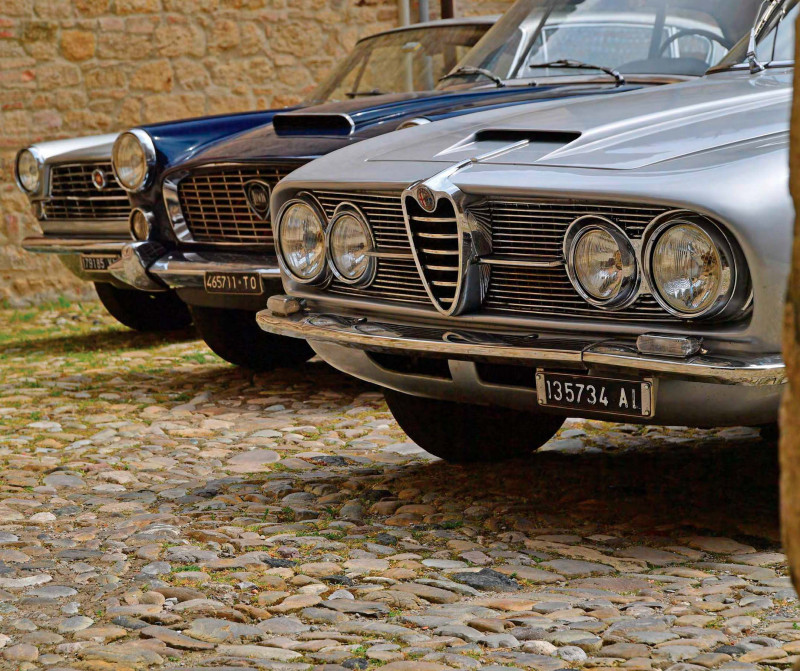
Our trio starts with the Lancia Flaminia Coupé 2.5 3B (here a 1962 example), the Alfa Romeo 2600 Sprint (1964) and the Fiat 2300 S Coupé (1966). Each had input from a different Italian design house: respectively Pinin Farina, Bertone and Ghia. Apart from their twodoor coupe bodywork, the other big thing that links all three is their six-cylinder powerplants. But which is the one we’d take home?
LEADING LANCIA FLAMINIA COUPÉ 3B
Lancia was the first manufacturer to try its hand in the upmarket coupe sector. When the Flaminia Coupé arrived in 1959, it was the only Italian example of a coupe derived from a saloon. Created on a platform that was 12cm shorter than the Berlina, the Coupé was born from a very illustrious mother: the 1956 Florida II concept, based on the Aurelia B56 chassis. Designed by Pinin Farina (then still written as two words), the Florida was used personally by ‘Pinin’ himself.
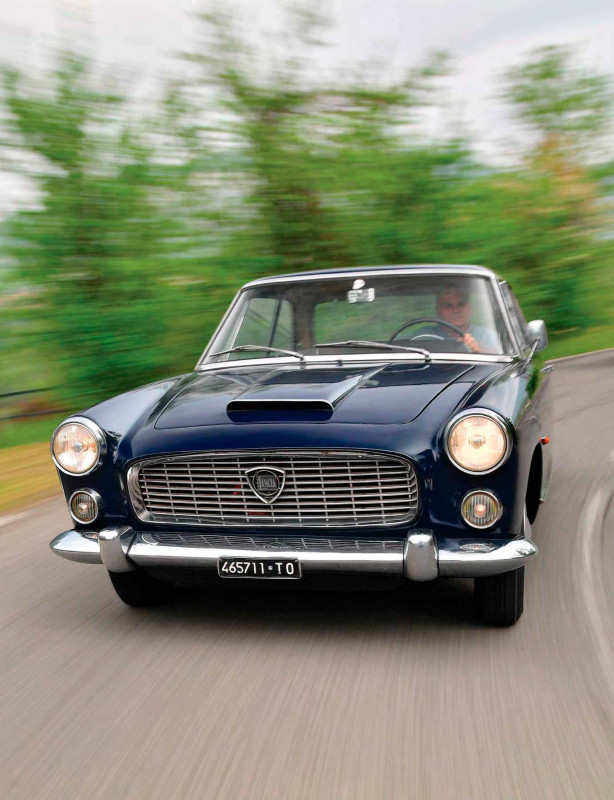
The Florida II was a very advanced expression of sharp edges and tight-radius curved lines which arguably revolutionised car styling at the end of the 1950s. It had four doors but looked like it had only two since the rear doors were hinged at the back and were only apparent once opened, thanks to the absence of external handles. Such a ‘clap-hands’ format was, according to technical director Antonio Fessia, too expensive and impractical for production, so a new two-door design was sought from Pinin Farina for the series Flaminia Coupé.
“ This is a car ideally suited to an autostrada run from Rome to the Amalfi coast, rather than a brisk run over Alpine passes ”
The cabin could seat four in comfort. Thanks to its elegance and exclusivity, it became the ideal vehicle for senior managers and celebrities. It was expensive: at launch, it cost 3,200,000 lire. The second series (as on these pages) arrived in 1962 and was called 3B. A novel triple-barrel carburettor was supplied by Solex for the 2.5-litre, six-cylinder, Aurelia-derived engine.
With 128hp, it boasted a top speed of 110mph. Our Blu Lancia-painted car was registered in 1962, making it one of the first 3Bs produced. The beautiful instrumentation derives from the Aurelia and the cabin has some wonderful original features, like seats in skai, a document holder on the right-hand side of the dash (a period item), and the centre armrest on the transmission tunnel. The carpet and electric windows were official Lancia options.
With a touch of choke, the engine fires up willingly. What the pushrod V6 lacks in raw power, it makes up for in smoothness and flexibility. This is a car designed to be driven smoothly, with a lively, versatile third gear and a precise-feeling gearbox. You can potter around at speeds as low as 10mph in third, then accelerate smoothly up to 70mph, pulling silkily to 5500rpm with only the whine of the alloy fan to indicate how hard you’re pushing. That said, this is a big, four-seater coupe and the heaviest of our trio at 1450kg, so it never feels truly lively.
The gear lever is a pleasure to use. The non-assisted steering is very heavy at low speeds but there is something satisfying about the smooth mechanical precision of the helm once underway. It has a precise, slop-free feel, belying its four-plus turns between locks.
As for the ride/handling balance, the Flaminia feels solid and doesn’t wallow or float, riding well on its tall, skinny tyres, and it displays pleasingly neutral cornering characteristics. The brakes are strong and reassuring, too.
This may not be a road-burner but it has a wonderfully refined and dignified character: mature and smooth, a suave machine in every respect.
This splendid Flaminia 3B oozes quality. 2.5-litre V6 offers delicious torque and smoothness
TECHNICAL SPECIFICATIONS LANCIA FLAMINIA COUPÉ 3B
- ENGINE: 2458cc V6 OHC
- BORE X STROKE: 80mm x 81.5mm
- COMPRESSION RATIO: 9.1:1
- INDUCTION: 1 x Solex C35 carb
- MAX POWER: 128hp at 5600rpm
- TRANSMISSION: 4-speed manual
- TYRES: 175/400
- SUSPENSION: Wishbones, coil springs, anti-roll bar (front), de Dion axle, Panhard rod, leaf springs, anti-roll bar (rear)
- BRAKES: Discs (front and rear)
- DIMENSIONS: 4680mm (L), 1740mm (W)
- WEIGHT: 1450kg
- MAX SPEED: 110mph
- PRICE IN 1964: £3389
- VALUE TODAY: From £25,000
GIUGIARO’S TRAILBLAZER ALFA ROMEO 2600 SPRINT
Just as our Lancia was being made in 1962, Alfa Romeo was ready to present its own upmarket six-cylinder coupe: the 2600 Sprint (series 106.02). This was the evolution of the 2000 Sprint, which had originally been launched in 1960 – the very first commercial design of a 20-year-old Giorgetto Giugiaro for Bertone.
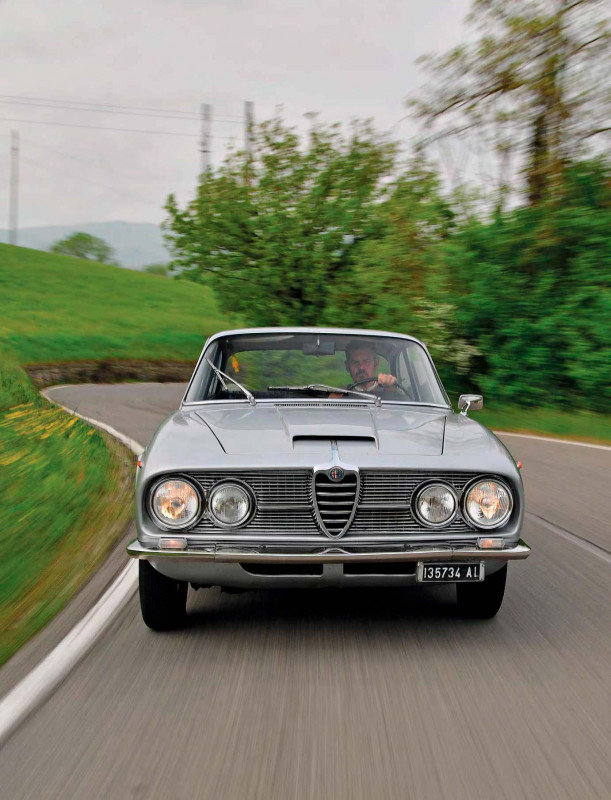
Like the Flaminia, the Sprint was based on a saloon platform whose wheelbase had been shortened (in this case to 2580mm). The look was almost unchanged from the 2000 Sprint, with twin headlights of different diameters inserted inside the grille itself, rather than being mounted on the bodywork. One difference was a slightly modified Alfa Romeo shield and new air intakes in the bonnet and front valance.
The reason for the new intakes lurked under the bonnet: the previous four-cylinder 2.0-litre lump was replaced by a splendid 2.6-litre six-cylinder. Although robust, this engine was already feeling a bit outdated by 1962, having been conceived by engineer Ciaccia under the guidance of Giuseppe Busso as early as 1956. Nevertheless, it had a great specification, consisting of an all-aluminium construction, twin-cam head, hemispherical combustion chambers and no fewer than three Solex 44 double-barrel carburettors. With 145hp, the 2600 Sprint could reach a maximum speed of 124mph, all for 2,900,000 lire.
The beautiful example featured in this test was registered in 1964 and has grey paint with a black leather interior – a really classy look. To drive, it quickly becomes apparent that the Alfa is the fastest of our trio. The way the engine delivers its performance is a delight: flexible and torquey and with effortless cruising on a trailing throttle, but with throaty, rasping acceleration from 4000rpm up to and beyond the redline at 6500rpm. It’s matched by a beautifully positive gearchange from the five-speed ’box.
This is a car better suited to an autostrada run from Rome to the Amalfi coast, rather than a brisk blast over Alpine passes. That’s because bends are not its forte. Narrow 165 tyres and a nose-heavy weight distribution result in major understeer that can all too quickly snap into oversteer if you don’t treat it gently. And while the non-assisted steering has plenty of feel and is great on the open road, it can be a real challenge at low speeds. The powerfully servo’d brakes need a gentle touch, too.
Classy Alfa feels the quickest of our trio on the road, with 145hp and a redline of 6500rpm.
TECHNICAL SPECIFICATIONS ALFA ROMEO 2600 SPRINT
- ENGINE: 2584cc in-line 6-cyl DOHC
- BORE X STROKE: 83mm x 79.6mm
- COMPRESSION RATIO: 9:1
- INDUCTION: 3 x Solex 44 carbs
- MAX POWER: 145hp at 5900rpm
- TRANSMISSION: 5-speed manual
- TYRES: 165/400
- SUSPENSION: Wishbones, coil springs, anti-roll bar (front), rigid axle, A-arm, rods, coil springs (rear)
- BRAKES: Discs (front), drums (rear)
- DIMENSIONS: 4580mm (L), 1706mm (W)
- WEIGHT: 1370kg
- MAX SPEED: 124mph
- PRICE IN 1964: £2899
- VALUE TODAY: From £35,000
“ The 2300 S is best described as a relaxing car to drive, rather than sporty. The silky powerplant is joyfully smooth ”
GRAND FIAT 2300 S COUPÉ
You may associate Fiat mostly with small cars like the 500 and 600, but once upon a time Fiat was bracketed equally among manufacturers of quality, style and performance. Its range included sports and luxury cars that were the envy of the whole world.
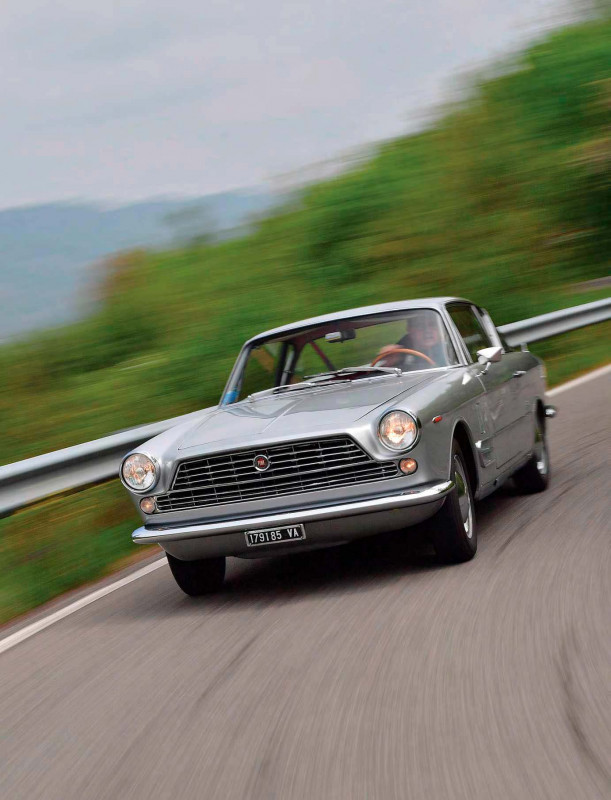
One such car was the 2300 Coupé. Its shape was the work of Sergio Sartorelli, who had been in place alongside Luigi Segre at Ghia since 1956. His work was a highly original take on the theme of a four-seater GT, elegant but at the same time sober. For instance, he resisted (fortunately) the temptation to succumb to tailfins that were all the rage at that time.
As soon as Fiat management saw the Ghia prototype at its debut at the 1960 Turin Motor Show, they pounced and asked to put the car into production virtually without any changes. At that time, Ghia was not able to take on manufacturing, even in small series, which is why Segre founded OSI (Officine Stampaggi Industriali) in a neighbouring warehouse, where he built the bodies not only of the 2300 Coupé but the Innocenti 950 and 1100 Spider, too.
Based on the technical basis of Fiat’s 2300 saloon, under the bonnet beats a noble heart: the in-line six-cylinder OHV pushrod engine developed by Aurelio Lampredi with the help of Carlo Abarth. In twin-carb ‘S’ form, its specific power output (59hp per litre) was very much up with its Alfa Romeo and Lancia competitors and the car was good for almost 120mph. It cost 3 million lire in 1966, somewhat less than the Alfa and Lancia.
Our 1966 example looks especially elegant in grey with a burgundy interior, the wide front seats offering great comfort. Fire up the ignition and you’re rewarded with a superbly silky powerplant that’s joyfully smooth. It emits a low growl on start-up and plenty of valve clatter at speed. It can rev to 6500rpm, but it really doesn’t need to be extended that far. At low revs, it’s a wonderfully torquey unit, while when cruising at 80mph, it feels totally at ease.
The 2300 S is best described as a relaxing car to drive, rather than sporty. The floor-hinged pedals work well, while the gear lever feels better than its severely canted-over stance might suggest (although it lacks a fifth ratio). The large, high-set helm delivers low-geared and heavy steering (once again, there’s no power assistance).
Around corners, the 165 tyres provide just enough feedback of what’s going on, and despite the limitations of the leaf-sprung rear end, the tail can be persuaded to come around gently and predictably. The disc brakes feel quite spongy on initial application and not quite as effective as you’d like for the pressure you’re applying.
Superb engine is one of the many delights awaiting the 2300 S driver but leafsprung rear feels outdated.
TECHNICAL SPECIFICATIONS FIAT 2300 S COUPÉ
- ENGINE: 2279cc in-line 6-cyl OHV
- BORE X STROKE: 78mm x 79.5mm
- COMPRESSION RATIO: 8.9:1
- INDUCTION: 2 x Weber 38 carbs
- MAX POWER: 136hp at 5600rpm
- TRANSMISSION: 4-speed manual
- TYRES: 165/15
- SUSPENSION: Wishbones, torsion bars, anti-roll bar (front), rigid axle, leaf springs, anti-roll bar (rear)
- BRAKES: Discs (front and rear)
- DIMENSIONS: 4620mm (L), 1635mm (W)
- WEIGHT: 1310kg
- MAX SPEED: 118mph
- PRICE IN 1964: £2611
- VALUE TODAY: From £20,000
VERDICT
These coupes all come from the heart of the Dolce Vita era, when the sun shone on Italy in every sense, and plenty of that sun shines through in these cars.
Classical elegance pervades all three, and each has its own very distinct character. The Flaminia is a masterclass of understated, effortless style; the Alfa a sensationally proportioned, unadorned masterpiece; the Fiat a unique shape of great charisma.
The differences extend to how each car drives, too.
You couldn’t call any of them truly sporty but that was never really their remit: they’re all about elegance and grand touring ease.
The Fiat is quirky in so many ways but despite having a superb engine it doesn’t quite match the allure of its more prestigious brethren. Its leaf-sprung rear end is ultimately telling.
It’s therefore a toss-up between the Lancia and the Alfa. The 2600 Sprint definitely feels the sportiest of the trio with its lusty powerplant and scintillating soundtrack. It isn’t the world’s greatest-handling coupe but then neither is the Lancia.
In the final analysis, it’s the sheer presence and upper-crustiness of the Flaminia that sways things for us. The Lancia feels like it comes from a different, somewhat superior planet to the others, where craftsmen cared about quality above all else. For a fanciful weekend fling in the Tuscan hills, we can’t imagine anything better to do it in.
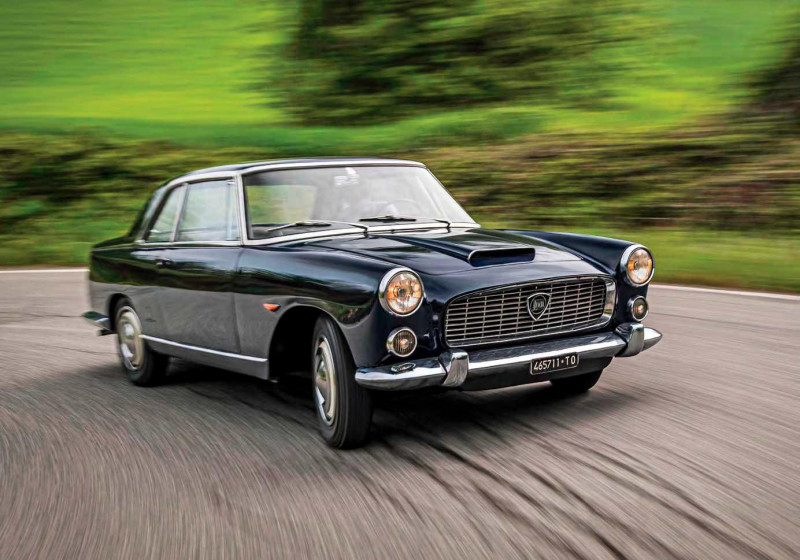
All three cars are hugely enjoyable to drive in grand touring style – but one does feel a true cut above


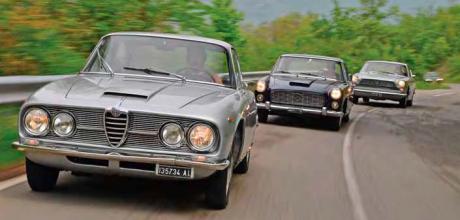
BRAKING BAD
Owning an Alfa Romeo 2600 Sprint, I thoroughly enjoyed reading the article about the model. My car is a 1964 model that, according to the Certificato di Origine, came off the production line on 8 April 1964 and was delivered to the UK on the 16th of that month (the chassis number being AR 854154). My car has disc brakes on all four wheels, as have all models thereafter. There was no official ‘Mark Two’ but several changes were introduced after my car was manufactured. For example, mine has singlepiece alloy bumpers, whereas the tested car has the later three-piece items, also the dashboard has a ‘grab handle’ on the passenger side whereas earlier cars, such as mine, do not. Also the door handles are different. All of which suggests that the car tested was a late 1964 edition which therefore should have disc brakes all round. I hope you don't consider the above to be too petty, but if the tested car does have drum rear brakes, then it is a bit of a mystery. As I stated above, I thoroughly enjoyed the article and certainly agree with the comment regarding being happier on an autostrada than twisty roads. To cope with this, I have electric power steering fitted which, whilst not standard, has transformed the driving experience.